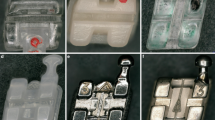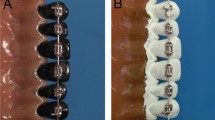Abstract
Objective:
Air-polishing devices (APDs) are used to clean and polish tooth surfaces. The objective of this study was to examine the effects of exposing orthodontic wires and brackets to different types of powder when using an APD.
Material and Methods:
Three different wire materials (steel, TMA, Ni-Ti) were polished using an APD (Air-Flow® S1), Clinpro™ Prophy and Air-Flow®. The exposure times were set at 5 and 10 seconds, the application distance at 2 and 4 mm. The wires were then measured for friction. The unpolished sections of the wires were used for control purposes. In a qualitative analysis, the brackets (steel, ceramic and plastic) were exposed for 5 s, 10 s, 30 s und 60 s from a distance of 2 mm using Clinpro™ Prophy and Air-Flow®. The polishing effects were then observed using a scanning electron microscope.
Results:
The unpolished TMA wire exhibited greater friction (1.22 N) than the Ni-Ti (0.82 N) and the steel wire (0.97 N). Polishing resulted in a 2.5% increase in friction on average (p = 0.004). There was no evidence of a change in the ceramic bracket surfaces. When the Air-Flow® device was used on steel brackets for longer exposure times, the result was a slight roughening of the surface. The plastic brackets exhibited changes that became more obvious after use of the Air-Flow® device.
Conclusions:
The surface changes in archwires and brackets caused by air-polishing devices when applying the Clinpro™ Prophy and Air-Flow® powders can be considered as marginal overall. When the adjacent periodontium is intact, both powders are equally suitable, although the Air-Flow® powder is somewhat more effective due to its greater abrasiveness. When using plastic brackets, Clinpro™ Prophy proved to be the powder of choice, thanks to its low abrasiveness.
Zusammenfassung
Ziel:
Pulver-Wasserstrahl-Geräte (PWS) werden zur Reinigung und Politur von Zahnoberflächen verwendet. In der vorliegenden Studie sollten die Auswirkungen einer Bestrahlung von kieferorthopädischen Drähten und Brackets mit einem PWS je nach Pulverart untersucht werden.
Material und Methodik:
Drei verschiedene Drahtmaterialien (Stahl, TMA, NiTi) wurden mit einem PWS (Air-Flow® S1) mit Clinpro™ Prophy und Air-Flow® bestrahlt. Als Bestrahlungsdauer wurden 5 und 10 Sekunden und als Bestrahlungsabstand 2 und 4 mm festgelegt. Die Drähte wurden anschließend einer Friktionsmessung unterzogen. Als Kontrolle dienten jeweils unbestrahlte Drahtsegmente. In einer qualitativen Analyse wurden Brackets (Stahl, Keramik und Kunststoff) für 5 s, 10 s, 30 s und 60 s mit Clinpro™ Prophy und Air-Flow® in einem Abstand von 2 mm bestrahlt. Anschließend wurden die Auswirkungen der Bestrahlung mit einem Rasterelektronenmikroskop (REM) dargestellt.
Ergebnisse:
Der TMA-Draht zeigte im unbestrahlten Zustand mit 1,22 N eine höhere Friktion als der NiTi-(0,82 N) und der Stahldraht (0,97 N). Durchschnittlich kam es durch die Bestrahlung zu einer Friktionszunahme von 2,5% (p = 0,004). Eine Veränderung der Oberflächen der Keramikbrackets konnte nicht festgestellt werden. Bei den Stahlbrackets kam es durch die Air-Flow®-Bestrahlung bei hohen Bestrahlungszeiten zu einer leichten Aufrauung der Oberfläche. Die Kunststoffbrackets zeigten deutliche Veränderungen, wobei diese beim Air-Flow® ausgeprägter erschienen.
Schlussfolgerungen:
Die Oberflächenveränderungen von Bögen und Brackets durch PWS mit den Pulvern Clinpro™ Prophy und Air- Flow® sind insgesamt als gering einzustufen. Bei einem intakten marginalen Parodont sind beide Pulver gleichermaßen geeignet, wobei das Air-Flow® Pulver aufgrund seiner etwas höheren Abrasivität eine etwas höhere Effektivität aufweist. Bei Verwendung von Kunststoffbrackets erweist sich das Clinpro™ Prophy aufgrund seiner geringen Abrasivität als das Mittel der Wahl.
Similar content being viewed by others
References
Angolkar PV, Kapila S, Duncanson MG Jr, Nanda RS. Evaluation of friction between ceramic brackets and orthodontic wires of four alloys. Am J Orthod Dentofacial Orthop 1990;98:499–506.
Atkinson DR, Cobb CM, Killoy WJ. The effect of an air-powder abrasive system on in vitro root surfaces. J Periodontol 1984;55:13–18.
Barnes CM, Hayes EF, Leinfelder KF. Effects of an airabrasive polishing system on restored surfaces. Gen Dent 1987;35:186–189.
Barnes CM, Russell CM, Gerbo LR, et al. Effects of an air-powder polishing system on orthodontically bracketed and banded teeth. Am J Orthod Dentofacial Orthop 1990;97:74–81.
Bester SP, de Wet FA, Nel JC, Driessen CH. The effect of airborne particle abrasion on the dentin smear layer and dentin: an in vitro investigation. Int J Prosthodont 1995;8:46–50.
Cacciafesta V, Sfondrini MF, Ricciardi A, et al. Evaluation of friction of stainless steel and esthetic self-ligating brackets in various bracket-archwire combinations. Am J Orthod Dentofacial Orthop 2003;124:395–402.
Downing A, McCabe J, Gordon P. A study of frictional forces between orthodontic brackets and archwires. Br J Orthod 1994;21:349–357.
Drescher D, Bourauel C, Schumacher HA. Der Kraftverlust durch Friktion bei der bogengeführten Zahnbewegung. Fortschr Kieferorthop 1990;51:99–105.
Drescher D, Laaser W, Schumacher HA. Materialtechnische Untersuchungen zum Problem der Friktion zwischen Bracket und Bogen. Fortschr Kieferorthop 1989;50:256–267.
Eliades GC, Tzoutzas JG, Vougiouklakis GJ. Surface alterations on dental restorative materials subjected to an air-powder abrasive instrument. J Prosthet Dent 1991;65:27–33.
Fuck L-M, Wilmes B, Gürler G, et al. Friktionsverhalten selbstligierender und konventioneller Bracketsysteme. Inf Orthod Kieferorthop 2007;39:6–17.
Galloway SE, Pashley DH. Rate of removal of root structure by the use of the Prophy-Jet device. J Periodontol 1987;58:464–469.
Garner LD, Allai WW, Moore BK. A comparison of frictional forces during simulated canine retraction of a continuous edgewise arch wire. Am J Orthod Dentofacial Orthop 1986;90:199–203.
Gerbo LR, Lacefield WR, Barnes CM, Russell CM. Enamel roughness after air-powder polishing. Am J Dent 1993;6:96–98.
Gerbo LR, Lacefield WR, Wells BR, Russell CM. The effect of enamel preparation on the tensile bond strength of orthodontic composite resin. Angle Orthod 1992;62:275–281.
Hannemann M, Diedrich P. Der Einsatz des Prophy-Jetätes zur Schmelz-politur nach der Bracketentfernung. Fortschr Kieferorthop 1986;47:317–326.
Hosoya Y, Johnston JW. Evaluation of various cleaning and polishing methods on primary enamel. J Pedod 1989;13:253–269.
Jost-Brinkmann PG, Radlanski RJ. Oberflächenbeeinflussung kieferorthopädischer Brackets durch Pulver-Wasserstrahlgeräte. Quintessenz 1996;47:219–227.
Kapur R, Sinha PK, Nanda RS. Comparison of frictional resistance in titanium and stainless steel brackets. Am J Orthod Dentofacial Orthop 1999;116:271–274.
Lubow RM, Cooley RL. Effect of air-powder abrasive instrument on restorative materials. J Prosthet Dent 1986;55:462–465.
Manschot A. Orthodontics and inadequate oral hygiene compliance as a combined cause of localized gingival recession: a case report. Quintessence Int 1991;22:865–870.
Orton GS. Clinical use of an air-powder abrasive system. Dent Hyg (Chic) 1987;61:513–518.
Petersilka GJ, Tunkel J, Barakos K, et al. Subgingival plaque removal at interdental sites using a low-abrasive air polishing powder. J Periodontol 2003;74:307–311.
Petersilka GJ, Bell M, Haberlein I, et al. In vitro evaluation of novel low abrasive air polishing powders. J Clin Periodontol 2003;30:9–13.
Petersilka GJ, Steinmann D, Haberlein I, et al. Subgingival plaque removal in buccal and lingual sites using a novel low abrasive airpolishing powder. J Clin Periodontol 2003;30:328–333.
Petersilka G, Faggion CM Jr, Stratmann U, et al. Effect of glycine powder air-polishing on the gingiva. J Clin Periodontol 2008;35:324–332.
Petersilka GJ, Bell M, Mehl A, et al. Root defects following air polishing. J Clin Periodontol 2003;30:165–170.
Schumacher HA, Bourauel C, Drescher D. Der Einfluss der Ligatur auf die Friktion zwischen Bracket und Bogen. Fortschr Kieferorthop 1990;51:106–116.
Scott L, Greer D. The effect of an air polishing device on sealant bond strength. J Prosthet Dent 1987;58:384–387.
Topoll H, Horvath G, Lange DE. Über die Oberflächenbeschaffenheit des Zahn-schmelzes, des Wurzelzementes und des Dentins nach Einwirkung von Ultraschall und Abstrahlung mit einem Wasser-Natriumbikarbonat-Gemisch. Dtsch Zahnarztl Z 1985;40:755–758.
Uchida T, Suda Y, Motohashi K, et al. The effect of an air polishing system on orthodontic materials and tooth surfaces. Shigaku 1986;74:377–390.
Weaks LM, Lescher NB, Barnes CM, Holroyd SV. Clinical evaluation of the Prophy-Jet and plaque. J Periodontol 1984;55:486–488.
Willmann DE, Norling BK, Johnson WN. A new prophylaxis instrument: effect on enamel alterations. J Am Dent Assoc 1980;101:923–925.
Yeung SC, Howell S, Fahey P. Oral hygiene program for orthodontic patients. Am J Orthod Dentofacial Orthop 1989;96:208–213.
Author information
Authors and Affiliations
Corresponding author
Rights and permissions
About this article
Cite this article
Wilmes, B., Vali, S. & Drescher, D. In-vitro Study of Surface Changes in Fixed Orthodontic Appliances Following Air Polishing with Clinpro™ Prophy and Air-Flow® . J Orofac Orthop 70, 371–384 (2009). https://doi.org/10.1007/s00056-009-9907-0
Received:
Accepted:
Published:
Issue Date:
DOI: https://doi.org/10.1007/s00056-009-9907-0




